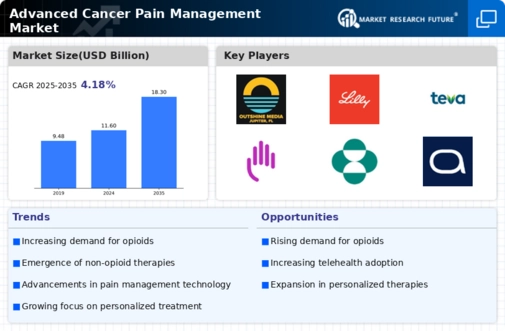Rising Incidence of Cancer
The increasing prevalence of cancer worldwide is a primary driver for the Advanced Cancer Pain Management Market. According to recent statistics, cancer cases are projected to rise significantly, with estimates suggesting that by 2040, the number of new cancer cases could reach 29.5 million. This surge in cancer diagnoses necessitates effective pain management solutions, thereby propelling the demand for advanced therapies and medications. As healthcare systems strive to address the complexities of cancer pain, the Advanced Cancer Pain Management Market is likely to experience substantial growth. The need for innovative pain relief methods, including opioids and non-opioid alternatives, is becoming increasingly critical as patients seek to improve their quality of life during treatment.
Increase in Geriatric Population
The aging population is a significant driver of the Advanced Cancer Pain Management Market. As individuals age, the risk of developing cancer increases, leading to a higher demand for effective pain management solutions. By 2030, it is estimated that the number of people aged 65 and older will reach 1.4 billion, many of whom will require advanced pain management due to cancer diagnoses. This demographic shift is prompting healthcare systems to adapt and expand their pain management services, thereby driving growth in the Advanced Cancer Pain Management Market. The need for tailored pain management strategies for older adults is becoming increasingly apparent, as this population often experiences unique challenges related to pain management.
Growing Awareness of Pain Management
There is a notable increase in awareness regarding the importance of effective pain management among healthcare professionals and patients alike. Educational initiatives and advocacy campaigns are emphasizing the need for comprehensive pain management strategies in cancer care. This heightened awareness is driving demand for advanced pain management solutions, as patients are more informed about their options and the potential benefits of various therapies. The Advanced Cancer Pain Management Market is likely to benefit from this trend, as healthcare providers are increasingly adopting multidisciplinary approaches to address pain, thereby enhancing the overall quality of care for cancer patients.
Advancements in Pain Management Technologies
Technological innovations are transforming the landscape of the Advanced Cancer Pain Management Market. The integration of digital health solutions, such as telemedicine and mobile health applications, is enhancing patient access to pain management services. Furthermore, advancements in drug delivery systems, including transdermal patches and implantable devices, are improving the efficacy of pain relief. These technologies not only facilitate better patient monitoring but also enable healthcare providers to tailor pain management strategies to individual needs. As a result, the Advanced Cancer Pain Management Market is witnessing a shift towards more personalized and effective treatment options, which could lead to improved patient outcomes and satisfaction.
Regulatory Support for Pain Management Solutions
Regulatory bodies are increasingly recognizing the need for effective pain management solutions in cancer care, which is positively impacting the Advanced Cancer Pain Management Market. Initiatives aimed at streamlining the approval process for new pain management therapies are emerging, facilitating quicker access to innovative treatments. Additionally, guidelines promoting the use of comprehensive pain management strategies are being developed, encouraging healthcare providers to adopt best practices. This regulatory support is likely to foster an environment conducive to the growth of the Advanced Cancer Pain Management Market, as it encourages investment in research and development of new therapies.

















Leave a Comment